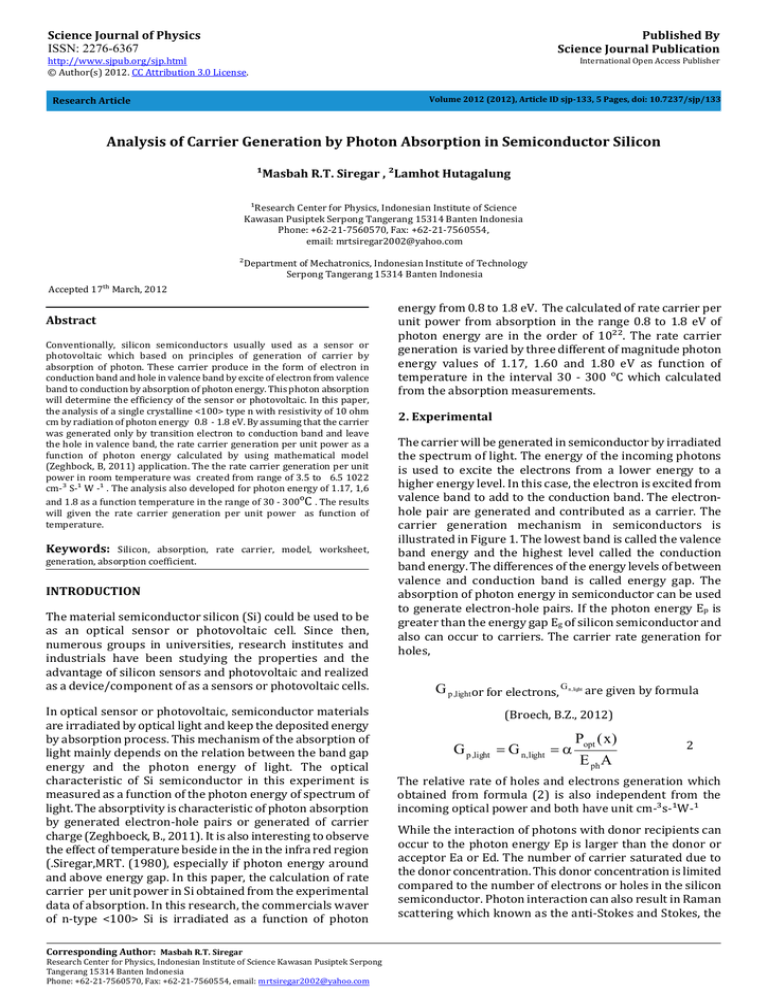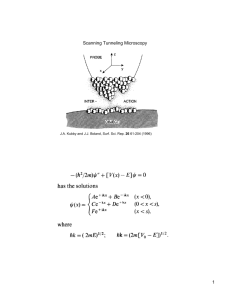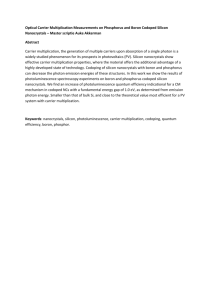Analysis of Carrier Generation by Photon Absorption in Semiconductor Silicon
advertisement

Science Journal of Physics ISSN: 2276-6367 Published By Science Journal Publication http://www.sjpub.org/sjp.html © Author(s) 2012. CC Attribution 3.0 License. International Open Access Publisher Volume 2012 (2012), Article ID sjp-133, 5 Pages, doi: 10.7237/sjp/133 Research Article Analysis of Carrier Generation by Photon Absorption in Semiconductor Silicon ¹Masbah R.T. Siregar , ²Lamhot Hutagalung ¹Research Center for Physics, Indonesian Institute of Science Kawasan Pusiptek Serpong Tangerang 15314 Banten Indonesia Phone: +62-21-7560570, Fax: +62-21-7560554, email: mrtsiregar2002@yahoo.com ²Department of Mechatronics, Indonesian Institute of Technology Serpong Tangerang 15314 Banten Indonesia Accepted 17�� March, 2012 Abstract Conventionally, silicon semiconductors usually used as a sensor or photovoltaic which based on principles of generation of carrier by absorption of photon. These carrier produce in the form of electron in conduction band and hole in valence band by excite of electron from valence band to conduction by absorption of photon energy. This photon absorption will determine the efficiency of the sensor or photovoltaic. In this paper, the analysis of a single crystalline <100> type n with resistivity of 10 ohm cm by radiation of photon energy 0.8 - 1.8 eV. By assuming that the carrier was generated only by transition electron to conduction band and leave the hole in valence band, the rate carrier generation per unit power as a function of photon energy calculated by using mathematical model (Zeghbock, B, 2011) application. The the rate carrier generation per unit power in room temperature was created from range of 3.5 to 6.5 1022 cm-³ S-¹ W -¹ . The analysis also developed for photon energy of 1.17, 1,6 and 1.8 as a function temperature in the range of 30 - 300�C . The results will given the rate carrier generation per unit power as function of temperature. Keywords: Silicon, absorption, rate carrier, model, worksheet, generation, absorption coefficient. INTRODUCTION The material semiconductor silicon (Si) could be used to be as an optical sensor or photovoltaic cell. Since then, numerous groups in universities, research institutes and industrials have been studying the properties and the advantage of silicon sensors and photovoltaic and realized as a device/component of as a sensors or photovoltaic cells. In optical sensor or photovoltaic, semiconductor materials are irradiated by optical light and keep the deposited energy by absorption process. This mechanism of the absorption of light mainly depends on the relation between the band gap energy and the photon energy of light. The optical characteristic of Si semiconductor in this experiment is measured as a function of the photon energy of spectrum of light. The absorptivity is characteristic of photon absorption by generated electron-hole pairs or generated of carrier charge (Zeghboeck, B., 2011). It is also interesting to observe the effect of temperature beside in the in the infra red region (.Siregar,MRT. (1980), especially if photon energy around and above energy gap. In this paper, the calculation of rate carrier per unit power in Si obtained from the experimental data of absorption. In this research, the commercials waver of n-type <100> Si is irradiated as a function of photon Corresponding Author: Masbah R.T. Siregar Research Center for Physics, Indonesian Institute of Science Kawasan Pusiptek Serpong Tangerang 15314 Banten Indonesia Phone: +62-21-7560570, Fax: +62-21-7560554, email: mrtsiregar2002@yahoo.com energy from 0.8 to 1.8 eV. The calculated of rate carrier per unit power from absorption in the range 0.8 to 1.8 eV of photon energy are in the order of 10²². The rate carrier generation is varied by three different of magnitude photon energy values of 1.17, 1.60 and 1.80 eV as function of temperature in the interval 30 - 300 �C which calculated from the absorption measurements. 2. Experimental The carrier will be generated in semiconductor by irradiated the spectrum of light. The energy of the incoming photons is used to excite the electrons from a lower energy to a higher energy level. In this case, the electron is excited from valence band to add to the conduction band. The electronhole pair are generated and contributed as a carrier. The carrier generation mechanism in semiconductors is illustrated in Figure 1. The lowest band is called the valence band energy and the highest level called the conduction band energy. The differences of the energy levels of between valence and conduction band is called energy gap. The absorption of photon energy in semiconductor can be used to generate electron-hole pairs. If the photon energy Ep is greater than the energy gap Eg of silicon semiconductor and also can occur to carriers. The carrier rate generation for holes, G p ,light or for electrons, G n , light are given by formula (Broech, B.Z., 2012) G p ,light = G n,light = a Popt ( x ) 2 E ph A The relative rate of holes and electrons generation which obtained from formula (2) is also independent from the incoming optical power and both have unit cm-³s-¹W-¹ While the interaction of photons with donor recipients can occur to the photon energy Ep is larger than the donor or acceptor Ea or Ed. The number of carrier saturated due to the donor concentration. This donor concentration is limited compared to the number of electrons or holes in the silicon semiconductor. Photon interaction can also result in Raman scattering which known as the anti-Stokes and Stokes, the Science Journals Publication(ISSN:2276-6367) injection of photoelectrons (X-rays), as well as other mechanisms. However, the quantity is very small compared with carrier generation. The other consideration is the energy gap of silicon which also as a function of temperature, where the gap decreases with increasing temperature. The temperature dependence of energy band gap, Eg, has been experimentally determined yield the following formula (3) (Varshni, Y.P., 1967) Page 2 3 where, Eg(0) = 1,116 eV, a = 0.473 meV/K and b = 636 K are the fitting parameters for semiconductor Si. For silicon semiconductors, the energy gap at room temperature is about 1.12 eV. Figure 1. The carrier generation mechanisms of semiconductors The density of carriers will determine the amount of electron effective mass, mn* and for the hole effective mass electrical current that occurs at the sensor and photovoltaic. is mp*. The electron effective mass mn* = 1.100 me and hole Electron and hole in the crystal is not completely free, since effective mass mp* = 0.56 me, where me is the electron rest the electron motion will be different in the free space. Thus, mass. Electron and hole concentration at the semiconductor the mass of the electron depends on the wave vector and material can be written as (Kittel C., 1967). the variation of the energy bands. This mass is called of where, Eg is the energy gap; Nc and Nv are the effective state density in the conduction and valence band. III. Results and Discussion In this experiment, the commercially Si single crystalline <100>, resistivity of 10 ohm-cm and the thickness of 0.4 mm were irradiated with light source by using Spectrophotometer UV-VIS/NIR (2001500 nm, Model Jasco V-570). The parameter results are absorption, transmission and reflection of sample as function of wave length (in the interval of 0.8 -1.8 eV photon energy ). The measurements result of absorption as a function of photon energy is processed to obtain the absorption coefficient ( ) and by using the formula , where I is the energy transmission, I0 is the energy that goes through the sample surface, and d is the thickness. The absorption coefficient as a function of photon energy is shown in Fig. 2. Figure 2. The absorption coefficient (cm-1) as a function of photon energy How to Cite this Article: Masbah R.T. Siregar, Lamhot Hutagalung, “Analysis of Carrier Generation by Photon Absorption in Semiconductor Silicon,” Science Journal of Physics, Volume 2012 (2012), Article ID sjp-133, 5 Pages, doi: 10.7237/sjp/133 Page 3 Science Journals Publication(ISSN:2276-6367) In Fig. 2, the curve of absorption coefficient versus photon energy is described the dynamics of absorption in silicon sample. The measurement results of absorption coefficient as a function of photon energy for the interval of 0.8 - 1.1 eV is very low. Since, there is a minimum creation of carrier in the conduction band to valence band. That's mean the carrier will be generated in the first interval in the stable condition, because the carrier generate only in the interband transition. In the second interval, the value about 1.1 to 1.2 eV, the absorption coefficients shown significantly increase with exponentially which indicating the starting of the transitions processes of electrons and holes to be generated a carrier. This carrier could be applied in the currentcarrying charge on the sensor and solar cell application. Then, above 1.2 eV, the absorption coefficient is become stable again, because the generation of carrier approximately constant. That implied the carrier concentration is saturated and has reached the optimum value of optical absorption. To understand all of these phenomena, the relative rate carrier generation per unit power are calculated by using the formula (2) as a function of photon energy. The results are given in the Fig 3. Figure 3. The rate carrier generation per unit power as a function of photon energy. In Figure 3, in the range below 1.1 eV , the rate is staring photon energy at approximately equal to the gap energy of high rate because the high rate of intra band transition and Si. Above 1.2 eV, the rate carrier is become decrease sharply decrease sharply. This phenomena is according to phonon again with the value of about 5.5 to 3.5 1022 cm-3 S-1 W-1. absorption mechanism. In this range of the electron-hole In this interval, the decreasing of rate due to the state of pairs or carrier is not formed, due only contributed by energy level was already occupied. To analyze the effect interband transition or phonon transition. The results with of temperature to the rate carrier generation, certain value photon energy in interval 0.8 to 1.1 eV are decrease of photon energy applied to the experiments set up, as significantly from 6.5 10 to 4.5 1022 cm-3 S-1 W -1. In the shown in Fig. 6. In the experiment set-up used the laser light interval 1.1 to 1.2 eV, the rates carrier generation are 4.5 to sources with three different wave lengths (i.e. 1.17, 1.60 and 5.5 1022cm-3 S-1 W-1, which shown that electron-hole pairs 1.80 eV). The heater (as source of heat) is attached to the is start to generated. In this interval, the transition will sample and controlled by thermostat apparatus. create the electron-hole pairs due to the magnitude of Figure 4. The experimental set up for absorption coefficient measurements as a function of temperature. How to Cite this Article: Masbah R.T. Siregar, Lamhot Hutagalung, “Analysis of Carrier Generation by Photon Absorption in Semiconductor Silicon,” Science Journal of Physics, Volume 2012 (2012), Article ID sjp-133, 5 Pages, doi: 10.7237/sjp/133 Science Journals Publication(ISSN:2276-6367) Page 4 The results of absorption coefficient from those three different values, 1.17, 1.6, and 1.8 eV, of photon energies as a function of temperature are shown in Fig. 5. Figure 5. The absorption coefficient as a function of temperature for photon energies 1.17, 1.60, and 1.80 eV In Fig. 5, the value of photon energies 1.6 and 1.8 eV which is greater energy than the energy gap of Si semiconductors, the absorption coefficient is not significantly increase (at the range of 80 to 130 cm-1) or rising slowly. The rising slowly is due to the decrease in energy gap as a function of temperature. At 1.17 eV, the absorption coefficient changes increase very sharply at the range of 80 to 500 cm-1 for 30 to 300 oC. It caused by the magnitude of the photon energy at almost equal to the energy gap and reduction factor as a function of temperature. The relative rate carrier absorption as function of temperature for these 1.17, 1.6 and 1.8 eV photon energy were calculated and shown in Fig. 6. Figure. 6. The rate carrier generation per unit power as function temperature at 1.17, 1.6 and 1.8 eV In photon energy of 1.17 eV which include in the interval of for the rate carrier generation per unit power at 1.6 and 1.8 1.1 eV to 1.2 eV (around the energy gap), the carrier rate eV is less influence to silicon semiconductor, thus the rate generation per unit power increase very sharply at the range carrier generation per unit power is only slowly changed of about 7 to 27 1022cm-3 S-1 W-1. It was not only caused with value from about 4.5 to 5.5 1022cm-3 S-1 W-1, due to by the magnitude photon energy which equal to the gap only influenced by the decreasing of energy gap as a function energy of Si, but also due to the effect of decreasing of energy of temperature. gap to the increasing of temperature. The temperature effect How to Cite this Article: Masbah R.T. Siregar, Lamhot Hutagalung, “Analysis of Carrier Generation by Photon Absorption in Semiconductor Silicon,” Science Journal of Physics, Volume 2012 (2012), Article ID sjp-133, 5 Pages, doi: 10.7237/sjp/133 Page 5 Science Journals Publication(ISSN:2276-6367) 5. Conclusions From the above analyses, the rate carrier generation per unit power in silicon can be concluded as follows. 1. The rate generation of electron or hole per unit power in the range of photon absorption is below of the energy gap semiconductor, due to only contribute by the interband transition in valence or conduction band for phonon excitation. This interband transition does not create the electron-hole pair (carriers). The interband transition in semiconductor silicon with photon energy below of energy gap was resulted about 6.5 to 4.5 1022cm-3 S-1 W -1. In the range around of energy gap, the rate per unit power increasing significantly from 4.5 to 5.5 1022cm-3 S-1 W-1, which caused by starting generation of electron-hole pairs due to the magnitude of photon energy at approximately equal to the gap energy of Si and in the range above energy gap of semiconductor Si, the rate carrier generation per unit power with the value about 5.5 to 3.5 1022 cm-3 S-1 W 1. 2. The temperature effect at 1.17 eV, the carrier generation per unit power is sharply increased, which caused not only by the magnitude photon energy equal to the gap energy of Si and also the effect of decreasing of energy gap as a function of temperature. At 1.6 and 1.8 eV, the rates carrier generation per unit power are slowly changed due to the effect of temperature dependence of energy gap only. Those mechanisms are the basic principle of rate carrier generation in the semiconductor due to the optical absorption process. Specifically, it is used to as an optical sensor or solar cell application. From the above results, it shows the relationship between the absorbed photon energy with the rate carrier generation per unit power and will determine the optimum performance of the optical sensor or photovoltaic. 6. Acknowledgments The authors would like thanks to Deni Shidqi Khaerudini and Dwi Bayuwati from Research Center for Physics LIPI, Serpong for optical measurement and discussions. This research was funded by Hibah Fundamental of DIKTI (Higher Educational) Ministry of National Education of Republic of Indonesia. The authors also thanks to Research Center for Physics LIPI and Department of Mechatronics of Indonesian Institute of Technology. References 1. Kittel, C. (1976). Introduction To Solid State Physics. 8th Edition, Univ. of California, Berkeley, pp. 228-32. 2. Siregar M.R.T.et al, Dynamic of CO2 Laser Heating In The Processing Of Silikon", Appl. Phys. Lett.,36, 1980, pp.787-788. 3. Varshni, Y.P. (1967). Temperature Dependence Energy Gap In Semiconductor. Physica 34, pp. 149-154. 4. Zeghboeck, B. (2011), Principle of Semiconductor Devices, Colorade.Press, Edition1,http://ecee.colorado.edu/ bart/book/book/index.html, Sections 2.81-2.85 How to Cite this Article: Masbah R.T. Siregar, Lamhot Hutagalung, “Analysis of Carrier Generation by Photon Absorption in Semiconductor Silicon,” Science Journal of Physics, Volume 2012 (2012), Article ID sjp-133, 5 Pages, doi: 10.7237/sjp/133







